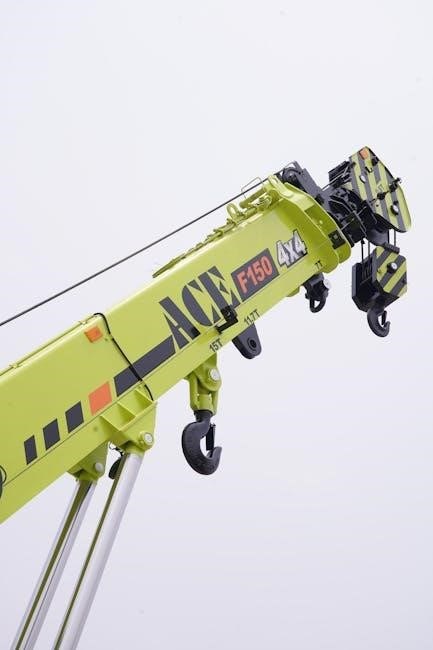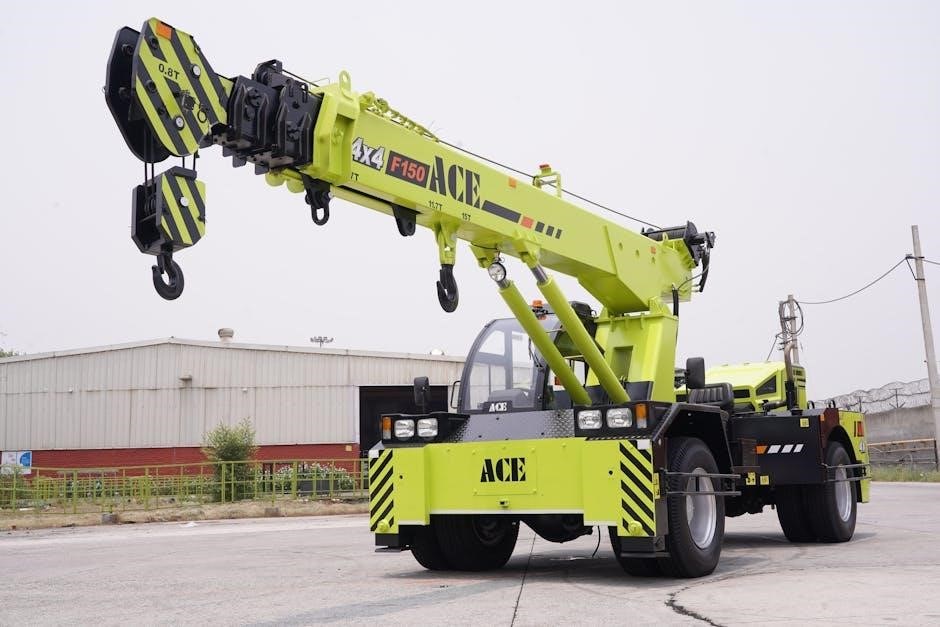The AS478 PDF is a standard specifying marking methods for aerospace parts, ensuring traceability and compliance with industry requirements. It outlines laser marking and alternative techniques, providing a comprehensive guide for engineers and manufacturers to meet quality and safety standards in aerospace engineering.
1.1 What is AS478?
AS478 is an aerospace engineering standard defining marking methods for parts and assemblies. It specifies techniques like laser marking and alternative methods to ensure traceability and compliance with industry requirements. The standard provides detailed guidelines for marking processes, ensuring clarity, permanence, and adherence to quality standards. AS478 is essential for maintaining product reliability and safety in aerospace applications, offering a structured approach to marking that aligns with engineering specifications and regulatory demands. Its purpose is to standardize marking practices, ensuring consistency across the aerospace industry while addressing specific material and design considerations.
1.2 Importance of AS478 in Aerospace Industry
AS478 is crucial for ensuring traceability, quality control, and compliance in aerospace manufacturing. It standardizes marking methods, enhancing safety and reliability by ensuring parts meet stringent industry specifications. Compliance with AS478 aids in product identification, verification, and maintenance of aerospace components. This standard is vital for maintaining high-quality production, reducing errors, and ensuring adherence to regulatory requirements. Its implementation fosters consistency across the industry, supporting the integrity and performance of aerospace systems. By providing clear guidelines, AS478 plays a pivotal role in upholding the high standards required for aerospace engineering and manufacturing.
1.3 Overview of the AS478 PDF Document
The AS478 PDF document is a comprehensive guide detailing marking methods for aerospace components. It covers laser marking requirements, material considerations, and quality control processes. The document outlines purpose and scope, referencing applicable standards and practices. Key sections include marking techniques, inspection criteria, and permissible styles. It serves as a reference for engineers to specify marking methods on engineering drawings. The PDF also addresses challenges and solutions in marking processes, ensuring compliance with aerospace standards. It is an essential resource for manufacturers aiming to meet industry specifications and maintain product reliability and safety in aerospace applications.

Purpose and Scope of AS478
AS478 defines and controls marking methods for aerospace parts, ensuring traceability and compliance with industry standards. It provides a structured approach for specifying marking requirements on engineering drawings.
2.1 Definition and Objectives of AS478
AS478 is a standard that defines and controls marking methods for aerospace parts and assemblies, ensuring traceability and compliance with industry requirements. Its primary objective is to provide a structured approach for specifying marking methods on engineering drawings, enabling clear identification of parts throughout their lifecycle. The standard focuses on laser marking and alternative techniques, ensuring consistency, readability, and durability of marks under various environmental conditions. By standardizing marking practices, AS478 supports quality control, product reliability, and safety in the aerospace sector, aligning with global aerospace standards and fostering efficient supply chain operations.
2.2 Scope of Application in Aerospace Engineering
The AS478 standard applies to the marking of aerospace parts, components, and assemblies, ensuring compliance with aerospace engineering requirements. Its scope includes specifying marking methods for identification, traceability, and quality control. The standard addresses various materials and surfaces, providing guidelines for permanent and durable markings that withstand environmental stresses. It is particularly relevant for suppliers, manufacturers, and quality assurance teams in the aerospace industry. By adhering to AS478, organizations ensure that marked parts meet safety, reliability, and regulatory standards, supporting the integrity of aerospace systems and components throughout their lifecycle.
2.3 Key Sections of the AS478 Standard
The AS478 standard is divided into key sections that address marking methods, material considerations, and quality control. Section 1.1 outlines the purpose of defining and controlling marking methods for aerospace parts. Section 3 details marking techniques, including laser marking requirements and alternative methods. Section 4 focuses on material considerations, ensuring markings are durable and compatible with various aerospace materials. Section 5 covers quality control and inspection criteria, ensuring compliance with industry standards. These sections collectively provide a comprehensive framework for specifying, executing, and verifying markings on aerospace components, ensuring traceability, safety, and reliability in aerospace manufacturing and operations.

Key Sections of AS478 PDF
The AS478 PDF includes sections on marking methods, material considerations, and quality control. It details techniques like laser marking, material compatibility, and inspection criteria for aerospace parts.
3.1 Marking Methods and Techniques
The AS478 PDF elaborates on various marking methods, emphasizing laser marking as a preferred technique for its precision and durability. It also covers alternative methods such as chemical etching and mechanical engraving, providing guidelines to ensure legibility and permanence of marks. The document specifies that the marking style should be clearly defined on engineering drawings, allowing manufacturers to choose the most suitable technique based on material and application requirements. Additionally, it outlines best practices for maintaining consistency and adherence to aerospace industry standards, ensuring that all marked parts meet stringent quality and traceability criteria.
3.2 Material Considerations for Marking
The AS478 PDF emphasizes the importance of material compatibility when selecting marking techniques. Different aerospace materials, such as titanium, aluminum, and composites, require specific methods to ensure mark durability and readability. Laser marking is often preferred for its adaptability to various materials, but the document also addresses considerations for chemical etching and mechanical engraving. It highlights potential material limitations, such as thermal sensitivity or surface finishes, that could affect mark quality. By adhering to AS478 guidelines, manufacturers can ensure that markings remain legible and consistent, even under extreme environmental conditions, while maintaining material integrity and structural safety.
3.3 Quality Control and Inspection Criteria
The AS478 PDF establishes rigorous quality control and inspection standards to ensure marking accuracy and durability. It specifies criteria for mark readability, legibility, and resistance to environmental factors like heat and chemicals. Verification processes include visual inspections and automated systems to verify compliance. The document emphasizes the importance of maintaining detailed documentation of inspection results. Proper quality control ensures that marked parts meet aerospace industry standards, guaranteeing traceability and reliability. Adherence to these criteria minimizes errors and ensures compliance with regulatory requirements, ultimately contributing to the safety and performance of aerospace components.

Marking Methods in AS478
AS478 introduces various marking methods, with a focus on laser marking as a primary technique. It defines controlled processes for specifying marking requirements on aerospace components.
4.1 Laser Marking Requirements
AS478 outlines specific requirements for laser marking, ensuring consistency and quality in aerospace applications. It details parameters such as power settings, wavelength, and pulse duration to achieve precise marks. The standard emphasizes material compatibility, focusing on metals like aluminum, titanium, and steel. Surface preparation and post-marking treatments are also specified to ensure durability and readability. Compliance with these requirements guarantees that laser-marked parts meet aerospace industry standards for traceability, safety, and reliability. Proper documentation of laser settings and validation processes is mandatory to maintain compliance and quality control.
4.2 Alternative Marking Techniques
AS478 recognizes alternative marking techniques to accommodate various materials and applications. Chemical etching is a common method, using corrosive substances to create permanent marks. Mechanical engraving, which physically removes material, is another option. Dot peen marking, a pneumatic or electronic process, is versatile for different surfaces. These methods are chosen based on material compatibility, durability, and readability requirements. Each technique must meet AS478’s quality and legibility standards. Proper training and equipment are essential to ensure consistency and compliance. Alternative techniques are critical for parts unsuitable for laser marking, ensuring traceability and reliability in aerospace components.
4.3 Permissible Marking Styles
AS478 outlines permissible marking styles to ensure clarity and consistency in aerospace part identification. The standard specifies acceptable fonts, such as Arial or Helvetica, and character sizes to maintain readability. It also defines layout configurations, including spacing and orientation, to prevent ambiguity. Additionally, AS478 addresses surface finish considerations, ensuring marks remain legible even after processing. These guidelines promote uniformity across manufacturers, facilitating traceability and quality control. Compliance with these styles is critical for maintaining safety and reliability in aerospace applications. Proper style adherence ensures that marked parts meet the industry’s stringent requirements for identification and tracking throughout their lifecycle.

Application of AS478 in Aerospace
AS478 is crucial for ensuring compliance, traceability, and quality in aerospace manufacturing, guiding the industry in producing reliable and safe components for aircraft and spacecraft systems.
5.1 Engineering Drawings and Specifications
AS478 provides detailed guidelines for engineering drawings and specifications, ensuring consistency in marking aerospace components. It outlines requirements for symbols, labels, and formatting, aligning with industry standards. The document specifies how markings should be integrated into design plans, ensuring clarity and compliance. Proper adherence to these specifications facilitates manufacturing, inspection, and traceability. By standardizing marking practices, AS478 enhances the accuracy and reliability of aerospace engineering drawings, contributing to overall product quality and safety.
5.2 Compliance with Aerospace Standards
Compliance with aerospace standards is critical for ensuring the integrity and reliability of marked parts. AS478 aligns with broader industry regulations, providing a framework for traceability, material verification, and documentation. Adherence to these standards minimizes errors and ensures consistency across manufacturing processes. By following AS478 guidelines, organizations can meet stringent aerospace requirements, enhancing product quality and safety. Compliance also facilitates smoother audits and certifications, ensuring operational efficiency and adherence to global aerospace norms. Proper implementation of AS478 standards safeguards against non-conformities, maintaining trust and reliability in aerospace manufacturing and supply chains.
5.3 Industry Best Practices for Implementation
Successful implementation of AS478 requires adopting industry best practices tailored to aerospace manufacturing. Organizations should establish standardized workflows, ensuring all marking processes align with AS478 guidelines. Regular training programs for personnel are essential to maintain proficiency in marking techniques and quality control. Leveraging advanced technologies, such as laser marking systems, enhances precision and efficiency. Conducting periodic audits and assessments helps sustain compliance and identify areas for improvement. Collaboration with suppliers and stakeholders ensures a unified approach to implementing standards. By integrating these practices, companies can optimize their marking processes, ensuring consistency and adherence to AS478 requirements across all stages of production.

Compliance and Verification
Compliance with AS478 ensures adherence to aerospace marking standards, while verification processes confirm the accuracy and quality of marked parts through audits, inspections, and detailed documentation.
6.1 Ensuring Adherence to AS478 Guidelines
Ensuring adherence to AS478 guidelines requires implementing robust quality control processes and thorough verification steps. Training programs should educate employees on proper marking techniques and standards. Regular audits and inspections are critical to maintaining compliance, identifying deviations, and ensuring all marked parts meet specified requirements. Utilizing specialized software for design and verification can enhance accuracy. Continuous improvement initiatives, based on audit feedback, help refine processes and uphold the integrity of the marking system. Proper documentation and traceability measures further ensure that all guidelines are consistently followed across the production cycle.
6.2 Verification Processes for Marked Parts
Verification processes for marked parts involve meticulous inspection to ensure compliance with AS478 standards. Visual inspections are conducted to check clarity, legibility, and correctness of markings. Automated scanning systems may also be employed to verify data accuracy. Documentation of verification results is essential for traceability and quality control. Testing may include durability assessments to ensure markings withstand environmental conditions. These processes help maintain consistency, prevent errors, and ensure that all parts meet aerospace industry requirements. Proper verification is critical for reliability and safety in aerospace applications, ensuring components are properly identified and traceable throughout their lifecycle.
6.3 Documentation Requirements
Documentation requirements under AS478 ensure traceability and accountability for marked parts. Detailed records must include part identifiers, marking methods, and verification results. All documentation must be retained for the lifecycle of the component. Standardized formats are recommended for consistency and accessibility. Electronic or physical copies should be securely stored to prevent alteration or loss; Proper documentation supports compliance audits, traceability, and quality assurance. It also provides a clear audit trail for regulatory and customer inspections. Adhering to these requirements ensures transparency and accountability in the aerospace supply chain, maintaining the integrity of marked parts throughout their operational life.

Tools and Equipment for Marking
AS478 specifies tools like laser marking machines, accessories, and software for precise marking. Equipment maintenance and calibration are essential to ensure accuracy and durability over time.
7.1 Laser Marking Machines and Accessories
Laser marking machines are critical for AS478 compliance, offering high precision and durability. Common types include fiber, CO2, and Nd:YAG lasers, chosen based on material compatibility. Accessories like lenses, galvanometers, and f-theta lenses ensure accurate beam control. These machines are ideal for aerospace materials such as metals and plastics, providing permanent, readable marks. Proper configuration and maintenance are essential for consistent results. The selection of laser marking machines must align with AS478 standards to meet quality and reliability expectations in aerospace applications.
7.2 Software for Marking Design and Control
Software for marking design and control is essential for AS478 compliance, enabling precise design creation and machine operation. These programs allow users to generate complex markings, including logos, serial numbers, and 2D codes. Advanced features like serialization and data import/export simplify workflow. The software integrates seamlessly with laser marking machines, ensuring accurate control over parameters such as power, speed, and focus. Robust data management tools track production and maintain traceability. Regular updates and technical support ensure compatibility with evolving standards, making this software indispensable for aerospace marking operations adhering to AS478 guidelines.
7.3 Maintenance and Calibration of Equipment
Maintenance and calibration of marking equipment are critical to ensure compliance with AS478 standards. Regular servicing prevents equipment degradation and maintains marking quality. Calibration ensures accuracy in laser settings, focusing, and beam alignment. Manufacturers’ guidelines must be followed for scheduled maintenance, including lens cleaning and laser source checks. Firmware updates and hardware inspections are also essential. Proper record-keeping of maintenance activities is required for audit purposes. Neglecting maintenance can lead to non-compliant markings, potentially causing production delays or recalls. Consistent upkeep ensures reliable operation and adherence to AS478 requirements, safeguarding product quality and traceability in aerospace applications.

Challenges in Implementing AS478
Implementing AS478 involves challenges like material limitations, complex marking techniques, and stringent quality requirements, requiring specialized skills and equipment, while balancing cost and efficiency demands.
8.1 Common Issues in Marking Processes
Common issues in marking processes under AS478 include material limitations, inconsistent mark readability, and equipment maintenance challenges. Variations in material properties can affect mark quality, while improper laser settings may lead to faint or blurry marks. Additionally, contamination from dust or humidity can compromise mark integrity. Operator error, such as incorrect parameter setup, is another frequent issue. Ensuring precise control over marking environments and adherence to AS478 guidelines is critical to mitigating these challenges and achieving consistent, high-quality results in aerospace applications.
8.2 Material Limitations and Solutions
Material limitations in AS478 marking processes often arise from thermal conductivity, hardness, and surface finish. For instance, materials like titanium and aluminum may require adjusted laser settings to prevent damage or ensure readability. Coatings or anodized layers can also pose challenges, as they may not absorb laser markings effectively. To address these issues, pre-treatment processes such as cleaning or surface preparation are essential. Additionally, using contrast-enhancing coatings or adjusting laser parameters can improve mark durability and visibility. Material-specific guidelines in AS478 help ensure compatibility and optimal marking outcomes, maintaining compliance and quality in aerospace applications.
8.3 Training and Skill Development Needs
Effective implementation of AS478 requires specialized training and skill development. Technicians must understand the standard’s guidelines, marking techniques, and quality control processes. Training programs should focus on equipment operation, material interactions, and inspection methods. Hands-on practice with laser marking systems and software is essential. Additionally, understanding aerospace regulations and industry best practices ensures compliance. Continuous learning and certification programs help technicians stay updated on advancements. Supervisors should encourage cross-training to address resource constraints and enhance team versatility. Investing in workforce development ensures high-quality, consistent marking processes, critical for aerospace safety and reliability.

Importance of AS478 in Quality Control
AS478 ensures traceability, product reliability, and safety in aerospace manufacturing. It establishes clear marking standards, enhancing quality control processes and supply chain efficiency.
9.1 Role of Marking in Traceability
AS478 emphasizes permanent, legible part marking to ensure traceability. Unique identifiers like serial numbers enable tracking from production to end-of-life. This enhances accountability, safety, and quality control in aerospace manufacturing by maintaining a clear record of each component’s origin, history, and usage, which is crucial for regulatory compliance and product reliability. Consistent, durable markings facilitate efficient identification and verification, reducing errors and recalls while improving supply chain transparency and operational efficiency across the industry.
9.2 Impact on Product Reliability and Safety
Accurate and durable part marking per AS478 enhances product reliability by preventing part mix-up and ensuring proper identification. Clear, permanent markings reduce operational risks, especially in aerospace, where component failure can have critical consequences. Compliance with AS478 ensures parts meet regulatory and safety standards, improving system performance and reducing the likelihood of errors. Proper identification also aids in maintenance, inspection, and recall processes, ensuring safer operation. By minimizing identification errors, AS478 contributes to the overall safety and reliability of aerospace systems, protecting lives and equipment while maintaining industry trust and compliance with stringent safety protocols.
9.3 Contribution to Supply Chain Efficiency
AS478 standardizes part marking, ensuring consistency across the aerospace supply chain. This uniformity simplifies inventory management, reduces errors in part identification, and accelerates shipping processes. By enabling rapid verification of parts, AS478 minimizes delays and enhances operational efficiency. Compliance with AS478 fosters trust among suppliers and manufacturers, streamlining communication and collaboration. Additionally, standardized marking reduces administrative burdens and lowers operational costs. These efficiencies contribute to a more agile and responsive supply chain, ultimately supporting the timely delivery of high-quality aerospace products and maintaining industry competitiveness on a global scale.

Future Trends in Aerospace Marking
Emerging technologies like advanced laser marking and AI-driven systems will enhance precision and speed. Sustainable practices and Industry 4.0 integration are expected to shape future aerospace marking standards.
10.1 Advancements in Laser Marking Technology
Advancements in laser marking technology are revolutionizing aerospace marking. High-precision fiber lasers now offer faster processing speeds and superior durability. Ultra-short pulse lasers minimize heat damage, preserving material integrity. AI-driven systems optimize marking parameters, ensuring consistency. Green lasers are emerging for non-traditional materials. Dynamic beam control enhances versatility. These innovations align with AS478 standards, ensuring permanent, legible marks. Enhanced traceability and compliance are key benefits, driving adoption across aerospace manufacturing. As technology evolves, laser marking will remain a cornerstone of efficient, high-quality aerospace component identification.
10.2 Integration of Automation and AI
The integration of automation and AI is transforming aerospace marking processes. Automated systems enhance efficiency, reducing manual errors. AI algorithms optimize marking parameters, ensuring compliance with AS478 standards. Predictive maintenance reduces downtime, while robotic systems handle complex marking tasks. AI-driven quality inspection ensures consistency and accuracy. Automation streamlines workflows, improving production scalability. These technologies enable real-time data analysis, boosting traceability and compliance. By integrating automation and AI, aerospace manufacturers achieve higher precision, faster turnaround times, and improved quality control, aligning with AS478 requirements for reliable and durable part marking in demanding aerospace environments.
10.3 Sustainability and Environmental Considerations
The AS478 standard emphasizes sustainability in aerospace marking processes. Eco-friendly practices, such as minimizing waste and reducing emissions, are prioritized. Laser marking is favored for its low environmental impact, as it avoids harmful chemicals. Energy-efficient laser systems align with sustainability goals. AS478 also promotes the use of recyclable materials and biodegradable consumables. Compliance with environmental regulations ensures responsible manufacturing. The standard encourages reducing the carbon footprint of marking processes, supporting greener aerospace production. By integrating sustainable practices, AS478 contributes to environmentally responsible aerospace manufacturing while maintaining high-quality part marking standards.
The AS478 standard is crucial for aerospace part marking, ensuring traceability and safety. Future trends include advanced laser technology and eco-friendly practices, enhancing industry efficiency and compliance.
11.1 Summary of Key Points
The AS478 standard is a critical guide for marking aerospace parts, ensuring traceability and compliance. It outlines methods, materials, and quality control measures, with a focus on laser marking. Compliance ensures product reliability, safety, and adherence to industry standards. Proper implementation enhances supply chain efficiency and reduces errors. The standard also addresses challenges like material limitations and training needs. By following AS478, manufacturers can achieve operational excellence and maintain trust in the aerospace industry. Its guidelines are essential for meeting regulatory requirements and delivering high-quality products consistently.
11.2 Final Thoughts on AS478 Implementation
Implementing AS478 requires careful planning, adherence to guidelines, and a commitment to quality. By following the standard, organizations can ensure accurate part identification, compliance, and traceability. It is crucial to invest in proper training, equipment, and processes to meet the requirements. The aerospace industry’s demanding nature makes AS478 indispensable for maintaining safety and reliability. Continuous improvement and adaptation to emerging technologies will help organizations remain compliant and competitive. Ultimately, AS478 implementation is not just a regulatory necessity but a cornerstone for operational excellence and customer trust in the aerospace sector.
11.3 Recommendations for Future Practices
Future practices should focus on adopting advanced marking technologies and investing in employee training programs. Organizations should prioritize collaboration with industry experts to share best practices. Emphasizing sustainable processes can reduce environmental impact while maintaining compliance. Regular reviews of the AS478 standard will help organizations adapt to updates promptly. Enhancing documentation and traceability systems ensures accountability and efficiency. By fostering innovation and continuous improvement, companies can stay ahead in meeting aerospace industry demands. These strategies will enhance overall compliance, productivity, and competitiveness in the global market.

